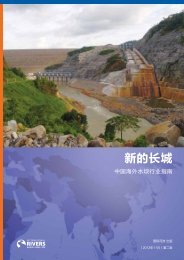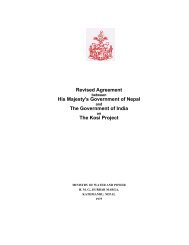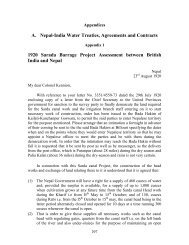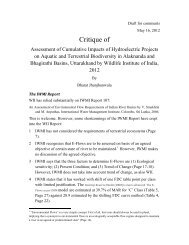<strong>Proposed</strong> <strong>Power</strong> <strong>Development</strong> <strong>Plan</strong> (<strong>PDP</strong>) <strong>2012</strong>and a Framework for Improving Accountability and Performance of <strong>Power</strong> Sector <strong>Plan</strong>ningThus far, about 82% of renewable energy actually online in <strong>Thai</strong>land is powered by biomass, accounting for 1,397MW out of a total of 1,698 MW. Biomass also accounts for nearly half of renewable energy projects that havesigned <strong>Power</strong> Purchase Agreements (PPAs) but are not yet constructed (Table 7). The “lowest hanging fruit”biomass resources in <strong>Thai</strong>land comprising agro-industrial waste from sugar factories, large rice mills, and lumbermills are already largely claimed, so rapid growth in the biomass sector is not expected. Solar electricity, on theother hand, is growing quickly. Total solar capacity installed is nearly doubling every six months, yet still accountsfor only 3.9% of total installed renewable energy. With over 2100 MW of signed PPAs, solar electricity may bepoised to overtake biomass in terms of installed capacity, especially taking into consideration recent dramaticdecreases in solar panel prices (LBNL, 2011).The key constraints to renewable energy in general and solar electricity specifically, are not technical, but are aresult of fairly recent changes that create considerable uncertainty in the policy environment. On June 28, 2010,the National Energy Policy Council (NEPC) passed a resolution 7 to stop accepting new applications for solarelectricity; reduce the adder rate for solar projects already submitted and under consideration; require bid-bondpayments for renewable energy project applications, and the establishment of the Managing Committee on <strong>Power</strong>Generation from Renewable Energy Promotion (hereafter, the “Managing Committee”) to police renewable energycompliance with policy.While all of these changes put a damper on renewable energy development, the most significant has been theactions of the “Managing Committee”. The Managing Committee comprises largely members from utilities andgovernment. In policing renewable energy projects “compliance with policy” a key concern is that the Committeelacks public oversight, creating fertile ground for confusion and doubts whether the Committee’s process is fair andimmune to business interests and political intervention (Tongtup, 2011; Bangkokbiznews, 2010). There are no clearguidelines on which projects will be approved first and which project are allowed to ‘jump the queue’, leaving roomfor rent-seeking by those with the authority to approve projects.New rules added by the committee expose projects to a crucial “Go / No Go” decision by committee members ongrounds that include subjective determinations such as the Committee’s assessment of the project’s financialstatus. Moreover, many applications are apparently stalled due to the lack of a definite timeline on how long theCommittee can take to process applications. With time-critical financing from banks and equity investors, delaysand uncertainty of this nature is often deadly for projects.As of this writing, new applications for solar electricity are still not accepted, and since the Managing Committeehas been active, very few new renewable energy projects using other types of fuels have achieved PPAs.Even with no new applications accepted, the (large) solar electric pipeline of 2100 MW of PPAs and 2500 MW ofother renewables are being built-out, some quite rapidly. There is a particularly hot market for signed solar PPAs,with these legal documents reportedly fetching prices as high as million baht (US$30,000) per MW.The <strong>PDP</strong> 2010 calls for a cumulative 4617 MW of new renewable energy between 2011 and the year 2030. This isactually less than the 4622 MW of already operating renewable energy plus signed PPAs in the pipeline as ofSeptember 2011. Thus, it would seem that the <strong>PDP</strong> 2010 figure is low -- especially considering that VSPP or SPPconstruction and commissioning generally takes less than two years, and the falling prices for solar electricity andother renewable energy technologies.However, to be conservative, the <strong>PDP</strong> <strong>2012</strong> accepts the <strong>PDP</strong> 2010 projections for new renewable SPPs and VSPPs.Even with the dysfunction of the current renewable energy policy environment this will probably under-estimatethe amount of renewable energy that comes online by the year 2030. With policy reforms, much greater gains inrenewable energy can be achieved. Clearly industry is ready and willing to move quickly when allowed to do so.One question that needs resolution is how to weigh renewable energy in the <strong>PDP</strong>. That is, what portion of renewableenergy is “dependable capacity”. Dependable capacity is defined as capacity that can be relied on to be dispatchedto meet load. While some renewable energy technologies can store fuel (biomass, biogas), others depend on7These key policy changes were justifi ed by citing concerns about impacts of higher rates on consumers and concerns about thespeculative nature of some renewable energy contracts (2010). It is worth noting, however, that consumers themselves have not,as a rule, expressed disappointment or concern about renewable energy leading to higher tariff s.17
<strong>Proposed</strong> <strong>Power</strong> <strong>Development</strong> <strong>Plan</strong> (<strong>PDP</strong>) <strong>2012</strong>and a Framework for Improving Accountability and Performance of <strong>Power</strong> Sector <strong>Plan</strong>ningintermittent flows (solar, wind). One factor to keep in mind, however, is that <strong>Thai</strong>land’s peak load is driven by airconditioning, which peaks on hot, sunny days: precisely the times that solar generates the most power. Even atechnology like solar which cannot be dispatched at will may, because of its technical characteristics, also tend tobe available when it is needed most. With no moving parts and large numbers of inverters operating in parallel,solar electricity can be more reliable on sunny peak load times than fossil fuel generators.A second important factor in considering dependable capacity comes about as a consequence of large numbers ofsimultaneously operating plants. Utilities are used to the idea that thousands of customers turning on and off loadscan create a predictable daily load curve, even if predicting the instantaneous consumption of individual consumersis less certain. Similarly, large number of renewable energy generation result in a predicable supply curve even ifthe individual power plants are intermittent.The <strong>PDP</strong> 2010 uses dependable capacity ratios for renewable energy as shown in Table 8. In the <strong>PDP</strong> <strong>2012</strong>, we usethe same dependable capacity ratios for renewable energy but note that, for reasons discussed above, thesenumbers are very low, particularly for solar and thus lead to undercounting renewable energy contributions indecreasing the need for conventional generation. We see a need for more research to better understand theeffective dependable capacity of renewable energy in <strong>Thai</strong>land in relation to the seasonal and diurnal variations in<strong>Thai</strong>land’s peak demand. In terms of their contribution to offsetting new generation called for in the <strong>PDP</strong> theseassumptions about dependable capacity are just as crucial as predictions of MW of installed capacity.REDependable capacitybiomass 40%biomass (rice husk) 70%biogas 21%solar 21%wind 5%small hydro 40%waste 20%*source: EPPO, http://www.eppo.go.th/power/pdp/page-7.html, 2010Table 8: Dependable c apacity of renewable energy generation as assumed in the <strong>PDP</strong> 2010 and the <strong>PDP</strong> <strong>2012</strong>CogenerationA cogeneration plant is a power plant that simultaneously produces both electricity and useful heat. Generally thismeans capturing the waste heat from the electrical generation process that, in a conventional power plant, wouldbe released through cooling towers and smokestacks. By making productive use of waste heat, cogeneration cansave considerable fuel compared to separate sources of electricity and industrial heat.Whereas the typical method of separate centralized electricity generation and on-site heat and/or steam generationhas a combined efficiency of 30 to 50 percent, cogeneration systems can reach efficiency levels of 90 percent. As aform of decentralized generation, cogeneration also reduces transmission losses due to its proximity to industrialor commercial applications that utilize both electricity and heat.<strong>Thai</strong>land has significant opportunities for cogeneration industrial heating as well as cooling in large hotels, shoppingmalls, and government buildings. An example many have experienced is Bangkok’s Suvarnabhumi Airport, in whichall cooling for the main terminal and surrounding facilities is accomplished with a lithium bromide chiller using“waste” steam from a 52 MW cogeneration system which also provides the electricity for the entire airport.Menke et al. (2006) examined a portion of the cooling market and identified 3500 MW of cogeneration in VSPPsystems sized from 400 kW to 10 MW providing cooling in commercial buildings including new shopping malls,hospitals, government buildings, and universities (Menke, Gvozdenac et al. 2006). Cogeneration for cooling alsohas the added benefit of significant electricity load reduction through reducing the need for new MW of capacity18
















